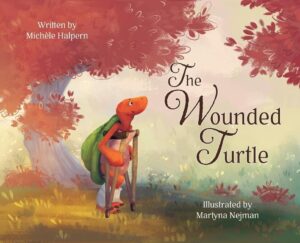
A poignant narrative that seamlessly weaves themes of resilience, community, and the imperatives of healing and recovery, The Wounded Turtle by Michèle Halpern with illustrations by Martyna Nejman is a charming read for all ages. Told through the allegorical journey of an injured turtle, the book captures the essence of vulnerability and the power of perseverance over hardship.
At the heart of the story is a nurturing turtle who is characterized by her dedication to aiding those in distress, a testament to the book’s exploration of empathy and service. When the turtle becomes the one in need after a devastating accident, the narrative shifts its focus toward the themes of receiving help and the challenges inherent in personal recovery, a transition that is handled with grace, guiding the reader through the emotional and physical journey to recovery.
Halpern’s storytelling is rich in playful imagery and emotion, especially in scenes such as the accident near the pond, the surgery, and the painstaking process of rehabilitation, which pull the reader into the pain, regret, and triumph that can come with an injury or illness. The array of characters, from Dr. Seagull to the supportive animal friends, illustrates the importance of community and solidarity in times of adversity, showing how no one should struggle alone. Martyna Nejman’s astounding illustrations give as much attention to the background details of each scene as each distinct character, while also breaking up key moments with a stark background that calls attention to the characters’ spirited reactions, giving the narrative an emotive sense of space and vitality.
However, while the imagery and story are immediately endearing, the intended audience of the book is occasionally unclear, seeming to be aimed more at adults than children in the complexity of language. Certain phrasing is far too complicated for young children, such as “At the one-year mark, progress grew spare, but each felt like a well-earned croix de guerre,” and parents will need to stop and explain certain ideas to young children. This is also heightened by the rhyming not always being consistent, or relying on slant rhymes, which can be too sophisticated for children.
Additionally, the message of the book is also somewhat inconsistent – while the turtle finds some sense of community during rehabilitation, her sense of alienation and isolation is palpable, and she only feels truly free once she is healed, calling the ordeal a “nightmare.” Adults would certainly respond in this way to an injury, but the message to children should veer more to the idea that freedom can be found in any situation, even during an injury, which is especially important for children whose injury or illness may last longer than others.
That said, the core theme of caring for one another comes through resoundingly, and the story skillfully addresses themes of hardship, healing, and the indomitable spirit of resilience. Plaintively written but charmingly sweet, Halpern’s work is an essential reminder of the importance of kindness, perseverance, and the strength of community, making it a valuable read for anyone seeking solace or inspiration in the face of daily challenges.
Book Links
STAR RATING
Design
Content
Editing
Get an Editorial Review | Get Amazon Sales & Reviews | Get Edited | Get Beta Readers | Enter the SPR Book Awards | Other Marketing Services























Leave A Comment